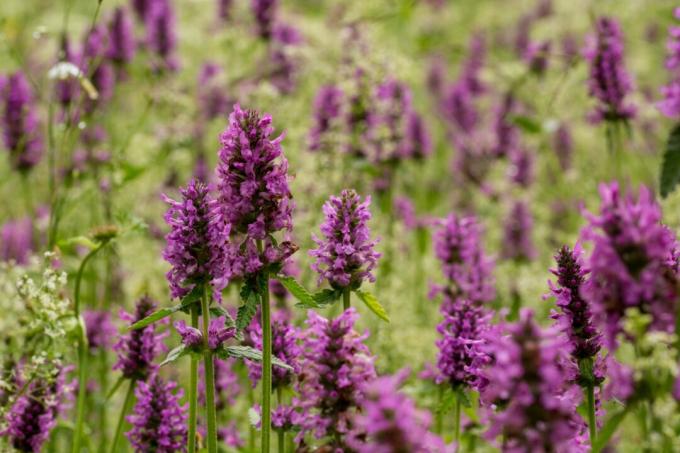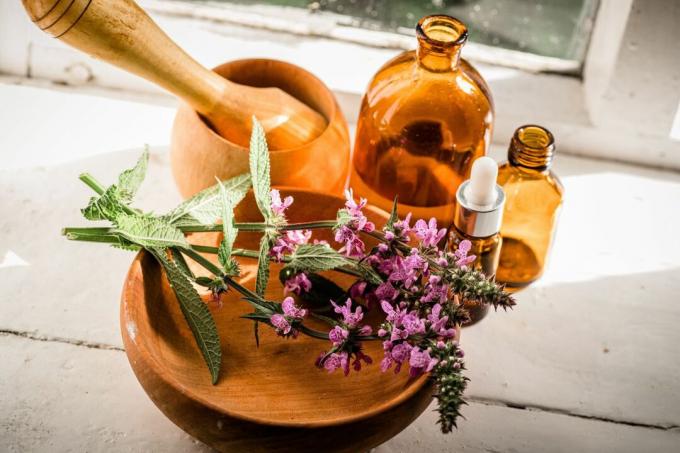The Heilziest was long considered an important European medicinal and magical plant. We present the perennial, bee-friendly perennial in a profile.

The Heilziest (Betonica officinalis Syn. Stachys officinalis) was an important medicinal plant in European herbal medicine in earlier times. We introduce the Heilziest and its effects, the demands in the culture and the most important care measures.
contents
- Heilziest: origin and characteristics
- Planting concrete: location and procedure
- Proper care
- Use and effect of the healing animal
- Is Heilziest poisonous?
Heilziest: origin and characteristics
The Heilziest is also known under the names Echte Betonie, Bathenia, Batunge, Fleablume, Pfaffenblume and Toothwort. The perennial plant belongs to the mint family (Lamiaceae) and is closely related to the native Waldziest (Stachys sylvatica) and Bulb ziest (Stachys affinis) related. It occurs wild all over Europe and in the Caucasus on meadows, in sparse forests and bushes. Until the Middle Ages, the Heilziest was an important medicinal plant in Europe and Egypt against a wide variety of ailments, but lost its importance completely.
The herbaceous plant reaches a height of 40 - 60 cm and forms family-typical square, slightly hairy stems. The leaves of the Heilziest sit cross-opposite on the shoots and together in front of the flower as a basal rosette of leaves. They are elliptical in shape, clearly serrated on the leaf margin and short-stalked to close-fitting. The lively inflorescence consists of numerous small, red-violet to white lip flowers. Pollinating insects, such as bees and butterflies, visit Heilziest during the flowering period from June to August to collect nectar and small amounts of pollen. In late summer, the flowers form the seed heads with four angular, brown Klausen fruits per pollinated flower.

Planting concrete: location and procedure
The ideal location for Heilziest is sunny to partially shaded on humus, loamy to clayey, but well-drained soils. It tolerates drought and needs medium amounts of nutrients. The real betony can be purchased as a potted perennial in nurseries and planted out in spring or late autumn.
Also possible, but much more time-consuming, is cultivation from the seeds of the medicinal zest. They are cold germers, meaning they need a longer period of winter-like temperatures to germinate. The seeds are therefore sown outdoors between September and December. Germination then takes place in spring when the temperature rises. However, it is also possible to sow Heilziest indoors all year round on a bright, warm window sill. The seeds are pre-soaked in lukewarm water for 24 hours, then stored in the refrigerator in damp sand or kitchen paper, ideally packed in a zip bag, for about eight weeks. Then the sowing takes place in cultivation containers. Pots or bowls are first made with low-nutrient potting soil, like ours Plantura organic herb & seed compost, filled and slightly moistened. The Heilziest seeds are sown 4 - 5 cm deep into the substrate and placed at room temperature. Germination takes a long time: it can take between 30 and 80 days for the first seedlings to appear. In the meantime, however, the earth must never dry out completely.
The young plants or perennials can be planted directly in the bed or in planters with a capacity of at least 5 liters in spring or late autumn. First remove unwanted weeds and loosen up the future location. Lean soils can be enriched with mature compost in this step. Now sufficiently large planting holes are dug and the Heilziest young plants are placed in them. The distance should be 25-30 cm. Then the planting holes are filled with soil, the plants are pressed well all around and watered.
At a glance: plant healing cysts
- Soil preparation: remove weeds, loosen soil and work in compost if necessary.
- Dig a sufficiently large planting hole, maintain a planting distance of 25 - 30 cm.
- Put concrete plants in, fill with substrate and press lightly.
- Water well after planting.

Proper care
The Heilziest is easy to care for and undemanding. If the perennials have grown well, watering is only necessary in exceptional cases in the event of prolonged drought. A predominantly organic fertilization in spring with an addition of ripe compost or ours Plantura organic universal fertilizer the Heilziest rewards with a rich flowering and strong growth. Heilziest is completely hardy down to below - 25 ° C in our latitudes and therefore does not need any winter protection. The perennial dies above ground in late autumn. Before the new shoots in the following spring, the dead plant parts are cut off near the ground. The clump-like cyst can be divided with a spade in autumn and thus propagated vegetatively.
Use and effect of the healing animal
The leaves of the Heilziest are cut and dried between July and August when they bloom. The herb contains up to 15% tannins and tastes quite bitter, which is why it is mainly used to support bleeding, digestion and liver function. Usually, the dried Betonienkraut is taken as Heilziest tea. The healing effects of Betonica officinalis can also have a positive effect on headache or toothache, gallbladder or kidney stones, gastrointestinal and respiratory diseases such as asthma or infections. In homeopathy it is Betonica officinalis Used for gallbladder disorders, gastrointestinal complaints and to support the liver and pancreas.
However, the use of Heilziest is not limited to medicine. The herb can also be used as a dye plant: wool and fabrics can be dyed yellow with it.

Is Heilziest poisonous?
Heilziest is not poisonous, but if consumed in excess can cause nausea, vomiting and, if overdosed, even hallucinations. As a precaution, pregnant and breastfeeding women should refrain from taking Heilziest. A related mint family with medicinal properties, particularly on the heart and circulatory system, is the motherwort (Leonurus cardiaca). We present the bumblebee-friendly medicinal plant in a profile.



